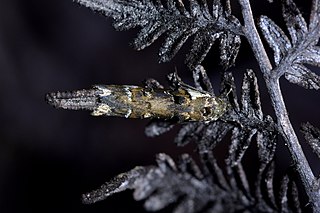Compsolechia is a genus of moths in the family Gelechiidae.

Izatha copiosella is a moth of the family Oecophoridae. It is endemic to New Zealand, where it is found on the south-eastern parts of the North Island and throughout the South Island except the West Coast. Larvae are found in dead wood and are likely to use kōwhai species as hosts. The adults are night fliers and are attracted to light. They are on the wing in January and February.
Ardozyga vacatella is a species of moth in the family Gelechiidae. It was described by Francis Walker in 1864. It is found in Australia, where it has been recorded from Queensland.
Compsolechia abolitella is a moth of the family Gelechiidae. It was described by Francis Walker in 1864. It was described from Australia.
Compsolechia abruptella is a moth of the family Gelechiidae. It was described by Francis Walker in 1864. It is found in Amazonas in Brazil and in Peru.
Compsolechia accinctella is a moth of the family Gelechiidae. It was described by Francis Walker in 1864. It is found in Amazonas in Brazil and in Peru.
Compsolechia binotatella is a moth of the family Gelechiidae. It was described by Francis Walker in 1864. It is found in Amazonas, Brazil.
Compsolechia monochromella is a moth of the family Gelechiidae. It was described by Francis Walker in 1864. It is found in Amazonas in Brazil and in Peru.
Compsolechia perlatella is a moth of the family Gelechiidae. It was described by Francis Walker in 1864. It is found in Amazonas, Brazil.
Compsolechia repandella is a moth of the family Gelechiidae. It was described by Francis Walker in 1864. It is found in Mexico, Colombia, southern Brazil and Guyana.
Compsolechia subapicalis is a moth of the family Gelechiidae. It was described by Francis Walker in 1864. It is found in Peru and Amazonas, Brazil.
Compsolechia tardella is a moth of the family Gelechiidae. It was described by Francis Walker in 1864. It is found in Peru and Amazonas, Brazil.
Compsolechia transjectella is a moth of the family Gelechiidae. It was described by Francis Walker in 1864. It is found in Peru and Amazonas, Brazil.
Compsolechia suspectella is a moth of the family Gelechiidae. It was described by Francis Walker in 1864. It is found in Amazonas, Brazil.
Compsolechia solidella is a moth of the family Gelechiidae. It was described by Francis Walker in 1864. It is found in Amazonas, Brazil.
Autosticha strenuella is a moth in the family Autostichidae. It was described by Francis Walker in 1864. It is found in Sri Lanka.
Tisis bicolorella is a moth in the family Lecithoceridae. It was described by Francis Walker in 1864. It is found on Borneo.
Lichenaula afflictella is a moth in the family Xyloryctidae. It was described by Francis Walker in 1864. It is found in Australia, where it has been recorded from Queensland.
Pedois tripunctella is a moth in the family Depressariidae. It was described by Francis Walker in 1864. It is found in Australia, where it has been recorded from Tasmania.

Trachypepla conspicuella is a species of moth in the family Oecophoridae. It is endemic to New Zealand and is found in both the North and South Islands. It is similar in appearance to its close relative T. euryleucota but tends to be paler. Its colouration imitates bird droppings. Larvae feed on leaf litter. Adults of this species are on the wing from November to February and have been observed resting on fences and walls.

